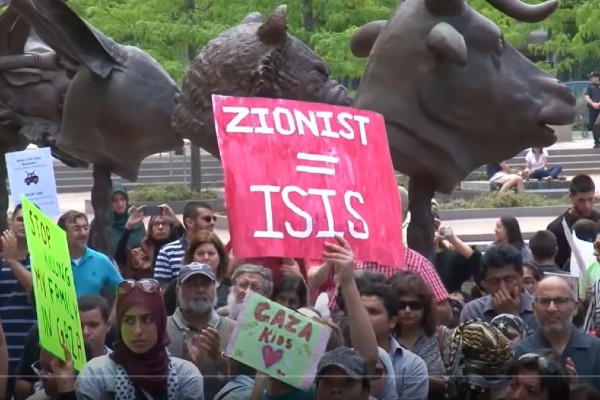There needs to be a minimal level of knowledge of historical facts before serious intellectual intercourse can be conducted on Twitter or other type-in-your-rant-and-insult locations.
By Yisrael Medad, JNS.org
It is becoming increasingly difficult for Zionists and pro-Israel activists to engage in dialogue, participate in panels or appear on the media to discuss issues relating to Israel.
No, not because the discourse is reaching intolerable depths of incivility or animosity, nor because of the increase in antisemitic hatred introduced into the conversation although that aspect, while central, is not new.
It is so due to the unbelievable ignorance, lack of knowledge and inability to grasp context. A minimal level of comprehension is missing.
I think that there needs to be a minimal level of knowledge of historical facts before serious intellectual intercourse can be conducted on Twitter or other digital platforms, including the “Comments” sections at student newspapers, news websites and other type-in-your-rant-and-insult locations.
Test yourself
To further that goal, I list below a few typical questions that should be asked of the participants who wish to engage in dialogue on topics of the current Arab conflict with Israel, the history of Zionism, the history of the Middle East and other issues, like Jewish world domination that occasionally creep (literally) into the exchange of opinions.
1. The name Palestine is the country in which Jesus was born. True or false?
2. Is Nablus an Arab name of a city in Palestine or a pronunciation corruption of the Latin Neapolis?
3. In 1919-20, Arab residents of the area soon to become the territory of the reconstituted Jewish national home referred to themselves as Southern Syrians and demanded they not be separated from Greater Syria. True or false?
4. In Ze’ev Jabotinsky’s 1923 article “The Iron Wall,” that was built of stone, iron or is it just a figure of speech?
5. In the Koran 17:1, the Prophet Muhammed was taken “to al-Masjid al- Aqsa,” the Furthest Mosque. As Muhammed died in 632 C.E., and Al-Aqsa was built later, is this a contradiction?
6. If pre-state immigration to Mandate Palestine included Jews from Yemen, Egypt, Morocco, Syria, Lebanon, Tunisia, Iraq, Afghanistan, Algeria, Sudan and Iran, why would Zionism be considered a “European movement”?
7. Avraham Shlomo Zalman Tzoref was stabbed by an Arab in Jerusalem in 1851 for repurchasing the Hurva Synagogue property and died. A) Was he Zionist? B) Was he an Arab terrorist?
8. During World War II, the leader of the Arabs of Mandate Palestine, the Mufti Amin al-Husseini, lived in Berlin and regularly broadcast pro-Nazi content, including references to a “worldwide Jewish conspiracy” that controlled the British and U.S. governments, and sponsored Soviet communism; and that “world Jewry” aimed to infiltrate and subjugate Palestine. Was the Mufti a Nazi, a Nazi collaborator or just an anti-Zionist?
9. Does the term “East Jerusalem” only refer to neighborhoods of Jerusalem to the east of a “West Jerusalem” or also to the south and north?
10. Abdullah I bin Al-Hussein was born in Mecca, the Hejaz, in 1881. When he arrived in the territory of Transjordan at Ma’an on Nov. 21, 1920, did he become a Transjordanian, a Jordanian or a Palestinian? Or did he remain a Hejazi?
11. UNRWA (the U.N. Relief and Works Agency for Palestine Refugees) defines a refugee from Palestine as one who lived there from June 1, 1946, to May 15, 1948. Do you think just two years is too short or too long a period of residence in the country to qualify?
12. The message of the chanted slogan “From the River to the Sea, Palestine will be free!” means: a) Palestine’s geographical boundaries are the Jordan River and the Persian Gulf? b) a final acceptance of the 1947 Partition Plan? c) Israel ceases to exist?
13. Does the 1949 Geneva Convention, Article 49, actually define “settlement activity” as “illegal” or does it read: “The Occupying Power shall not deport or transfer parts of its own civilian population into the territory it occupies”?
14. The text of the January 1919 Faisal-Weizmann Agreement reads in Article 1: “The Arab State and Palestine.” If there is an “Arab State,” is that “Palestine” a) another Arab state? b) a Jewish Zionist state? c) a Hejazi colony?
15. In 1964, when the Palestine Liberation Organization was founded, three years prior to the Six-Day War, what “Palestine” were they liberating: a) Jordan? b) the West Bank and Gaza? c) Israel?
16. Disregarding your answer to the previous question, why was an Arab Palestine not established between the years 1948 and 1967?
P.S. If you wish to text a Jewish friend or relative with this examination, it is suggested that you select any four questions and ask them at the upcoming Passover seder.
Yisrael Medad is an American-born Israel pundit and opinion commentator.
